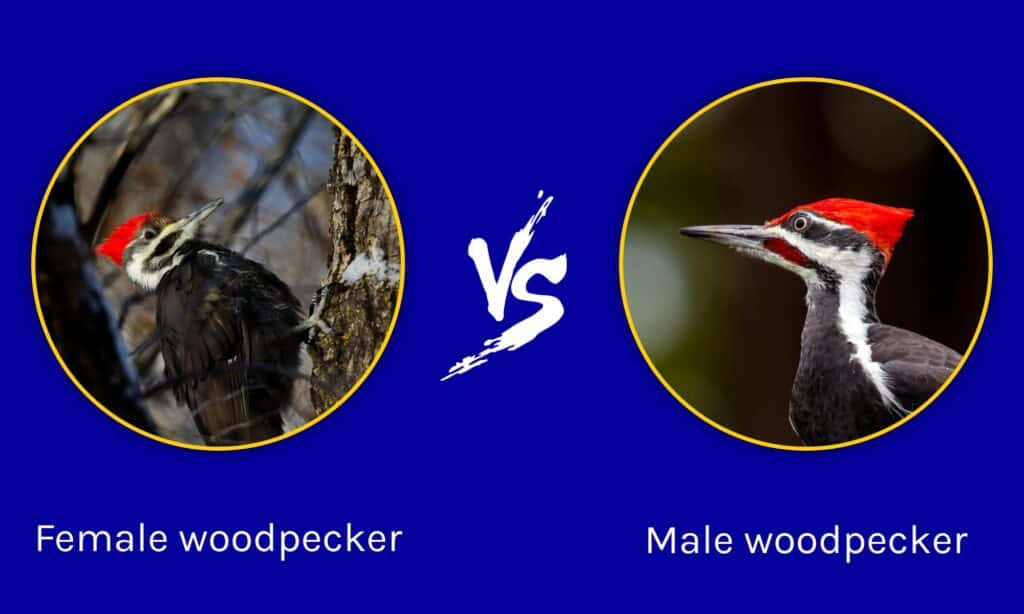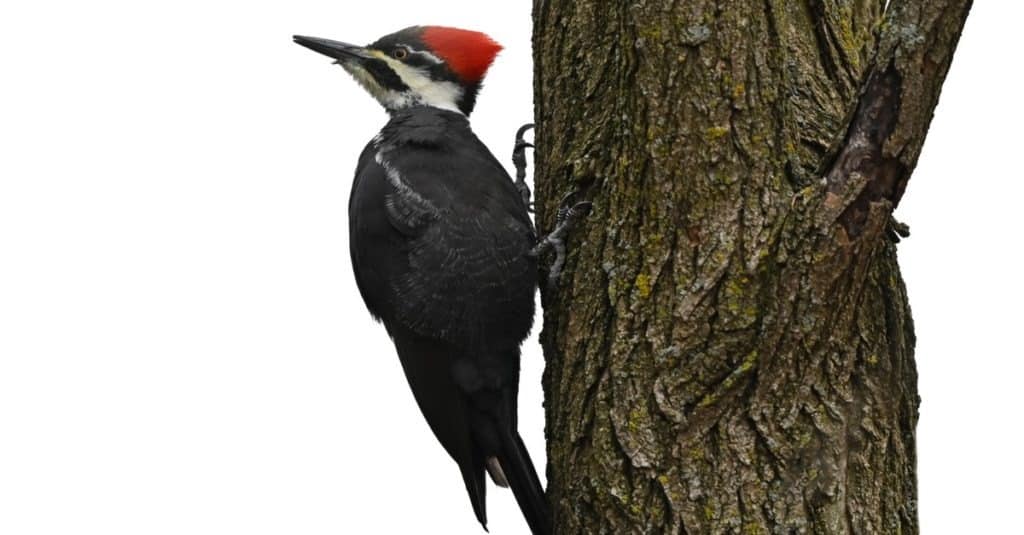The pileated woodpecker (Dryocopus pileatus) is one of the enormous forest birds known to man. It is Canada’s largest woodpecker with a length of 16 to 19 inches, and is also native to temperate North America. Pileated woodpeckers are monogamous and permanent residents.
Like every other woodpecker, they’re known for causing tree damages as they peck tree barks while looking for insects. The holes they bore in trees with their pecks can fell small trees. Pileated woodpeckers are beautiful birds with deep and loud hummings. They may live up to 12 years old.
Let’s examine the differences between the male and female pileated woodpeckers below.
Comparing Male Pileated Woodpeckers and Female Pileated Woodpeckers

| Male Pileated Woodpecker | Female Pileated Woodpecker | |
|---|---|---|
| Crest Length | Extensive, reaching the beak | Short |
| Nest Building | Excavates | Assists in excavation |
| Facial Markings | Red mustache | Black mustache |
| Reproduction and Nesting Behavior | Fertilizes the female and stays outside the tree cavity | Lays eggs and stays in the tree cavity |
The Key Differences Between Male vs Female Pileated Woodpecker
The male and female pileated woodpeckers have very similar characteristics, so it’s difficult to distinguish them. However, when you observe them closely, you’ll notice some differences. That’s especially when one focuses on their activities during nest building, facial markings, and crest.
While the male pileated woodpecker has a much longer red crest, the female pileated woodpecker has a shorter crest. Again, the male pileated woodpecker has red mustache, but the female pileated woodpecker is endowed with black mustache. They also have different behavior when building their nests because the male pileated woodpecker does the heavy lifting and wood excavation, while the female merely assists.
Let’s discuss the variations between both sexes in more detail below.
Male vs. Female Pileated Woodpecker: Crest Length

The female pileated woodpecker has a shorter crest than the male’s.
©MasterShopArt/Shutterstock.com
The male and female pileated woodpeckers have flaming red crests; this is perhaps their most striking attribute. Like all other birds with crests, pileated woodpeckers use their red crests for communication and protection. The male and female pileated woodpeckers’ flaming red crests look the same. However, when one looks closely, one will notice a difference in their length. The male pileated woodpecker’s triangular crest is long and extends greatly to its beak.
On the other hand, the female pileated woodpecker has a shorter crest that doesn’t extend past its forecrown, stopping just below the beak.
Male vs. Female Pileated Woodpecker: Nest Building
We mentioned earlier that woodpeckers are notorious for damaging trees with their beaks when searching for insects. Apart from hunting for their meals, these beautiful flying creatures also bore holes into trees to build their nests, thanks to their strong beaks and biological system that protects their brains with fluids as they peck. Pileated woodpeckers have square or rectangular cavities, unlike other woodpeckers with round or oval ones. While male and female pileated woodpeckers have similar beak features for pecking tree barks, only the males do the job during nest building. Female woodpeckers merely take on assisting roles in building their nests.
Male vs. Female Pileated Woodpecker: Facial Markings

Female pileated woodpeckers have black mustaches, while males have red mustaches.
©FotoRequest/Shutterstock.com
Yet again, the male and female pileated woodpeckers have the same basic coloration. They’re typically white, black, and red—much unlike many other bird species with different colors according to their sexes. However, carefully looking, one can differentiate the male and female pileated woodpeckers from their mustache color.
Also called stripes, the male pileated woodpeckers have a red mustache that runs from its bill down to its cheeks. Meanwhile, the female pileated woodpeckers have black mustaches.
Male vs. Female Pileated Woodpecker: Reproduction and Nesting Behavior
The male pileated woodpeckers fertilize the female while the female pileated woodpeckers lay the eggs. Apart from the differences in reproduction, you can also observe disparities in their nesting behaviors. Female pileated woodpeckers typically lay about four to six eggs simultaneously in their tree cavity. She never leaves the cavity as both the male and female pileated woodpeckers tend to their young for the first four weeks of their lives. The young, surprisingly, leaves the tree cavity at the end of the four weeks. Unlike female pileated woodpeckers, male pileated woodpeckers do not sleep in the cavity at night during the mother and her young bonding period. Interestingly, one notices them as they fly to another cavity, usually one they previously occupied.
Fun Facts about Pileated Woodpeckers
Now that you can tell the differences between the male and female pileated woodpeckers, let’s look at some fun facts:
- Pileated means crested or capped. This name takes after their flaming red crests that look like the “pileus,” a type of cap that Romans wear.
- You can tell that a pileated woodpecker bored into a tree bark by their distinctive markings.
- Pileated woodpeckers have a favorite food—carpenter ants, which make up a significant percentage of their diet. They lick up the carpenter ants after boring holes in trees or softwood with their tongues.
- Watch out for them in fall and winter if you are looking forward to sighting pileated woodpeckers. These are the seasons they leave the forests in search of food. Pileated woodpeckers love nuts and seeds during this time. So if you want to attract them, you know what to do.
- Pileated woodpeckers are large birds that like nesting on big trees. At about 16 to 19 inches in length and with a wingspan of around 29 inches, the pileated woodpecker is slightly smaller than an American crow.
- It is estimated that there are about 2 million pileated woodpeckers, so there are no concerns about their extinction.
- They engage in a courtship dance to woo their mate, after which they mate and live together all through their lifetime. If a partner dies, the surviving bird finds another mate.
- It is believed that from their coloring to their presence in dreams, the pileated woodpecker represents power, creativity, and sometimes, productivity.
- These lovely flying creatures have various diets, including wild fruits and nuts like blackberries, sumac berries, poison ivy, holly, dogwood, and elderberry.
The photo featured at the top of this post is © MasterShopArt/Shutterstock.com
Thank you for reading! Have some feedback for us? Contact the AZ Animals editorial team.






